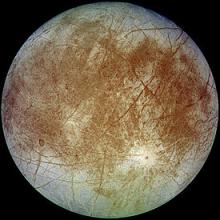The surface of of Europa looks like a bocce ball was hit by a lawn mower. There are huge canyons in tens-of-miles-thick sheets of ice that cover the surface of the small celestial body. The ice, researchers say, is constantly being shifting, cracked, and heaved by the vast oceans of water beneath. However, there are areas of the moon that are darker, where the ice sheets seem to be even more disturbed, more uneven, and more given to fluctuations than the rest of the surface. NASA now believes that these may be vast lakes trapped within the ice sheets, well above the oceans that lie much deeper toward the moon’s rocky core. These lakes create greater instability for the ice above them, creating these “matrix” dark spots and disturbed sections of the icy surface.
This begs the question; how can liquid water exist on a planet hundreds of millions of miles away from the sun (about five times the distance from the sun that Earth is)? The answer is in the immense gravitational pull of Jupiter and its other moons. As Europa revolves around its parent planet, the gravitational fields interact and Europa is actually flexed and pulled along its revolution. The flexing creates friction, which in turn heats the moon. The result is a moon where the surface, closest to the immense cold of space, is frozen, but the constantly moving and flexing underbelly remains warm enough to support liquid water.
This is perhaps the most exciting aspect of the new find, as a habitat warm enough to create liquid water, even encased as it may be in ice, may be able to support its own Europan life. What the life would look like is hard to say, just as it would be difficult to determine the chemical makeup of the liquid water beneath, but it remains a possibility. The lakes that so disrupt the icy surface may provide the necessary route for hydrocarbons, delivered by the sporadic comets and asteroids that pummel planetary surfaces, to reach the vast oceans near the moon’s warm rocky core. Once in that environment, scientists predict, life would have the opportunity to evolve in a relatively closed ecosystem.
